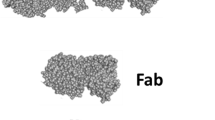Abstract
An IgG1 mouse monoclonal antibody directed against CEA has been digested with papain to yield F(ab)2 and Fab fragments. Following radioiodination, intact antibody and fragments showed specific binding to cells of a CEA-producing tumour, although the immune reactivities of the fragments were lower than that of intact antibody. Gamma scintigraphy of nude mice bearing CEA-producing human tumour xenografts and injected with 131I-labelled fragments showed earlier and superior imaging of tumours than did 131I-intact antibody, and this was most marked with the Fab fragment. Sequential dissection analyses showed that this was due to earlier and higher tumour-to-blood ratios with fragments than with intact antibody, but in absolute terms the degree of localization of both fragment types was significantly lower than that of intact antibody.
Similar content being viewed by others
References
Beaumier PL, Krohn KA, Carrasquillo JA, Eary J, Hellstrom I, Hellstrom KE, Nelp WB, Larson SM (1985) Melanoma localization in nude mice with monoclonal antibody Fab against p97. J Nucl Med 26:1172–1179
Buchegger F, Haskell LM, Schreyer M, Scazziga BR, Randin S, Carrel S, Mach JP (1983) Radiolabelled fragments of monoclonal antibodies against carcinoembryonic antigen for localization of human colon carcinoma grafted into nude mice. J Exp Med 158:413–427
Chatal J-F, Saccavini J-C, Fumolau P, Douillard J-Y, Curtet C, Kremer M, Le Mevel B, Koprowski H (1984) Immunoscintigraphy of colon carcinoma. J Nucl Med 25:307–314
Childs RL, Hnatowich DJ (1985) Optimum conditions for labeling of DTPA-coupled antibodies with Technetium-99m. J Nucl Med 26:293–299
Ey PL, Prowse Sj, Jenkin CR (1978) Isolation of pure IgG1, IgG2a and IgG2b immunoglobulins from mouse serum using protein A-sepharose. Immunochemistry 15:429–436
Fraker PJ, Speck JC (1978) Protein and cell membrane iodination with a sparingly soluble chloroamide 1,3,4,6-tetrachloro-3α, 6α-diphenylglycoluril. Biochem Biophys Res Commun 80:849–857
Gorini A, Medgyesi GA, Doria G (1969) Heterogeneity of mouse myeloma G globulins as revealed by enzymatic proteolysis. J Immunol 103:1132–1142
Herlyn D, Powe J, Alavi A, Mattis JA, Herlyn M, Ernst C, Vaum R, Koprowski H (1983) Radioimmunodetection of human tumor xenografts by monoclonal antibodies. Cancer Res 43:2731–2735
Keenan AM, Harbert JC, Larson SM (1985) Monoclonal antibodies in nuclear medicine. J Nucl Med 26:531–537
Laemmli UK (1970) Cleavage of structural proteins during the assembly of the head of the bacteriophage T4. Nature 227:680–685
Larson SM (1985) Radiolabelled monoclonal anti-tumor antibodies in diagnosis and therapy. J Nucl Med 26:538–545
Larson SM, Carrasquillo JA, Krohn KA, Brown JP, McGuffin JP, Ferens JM, Graham MM, Hill LD, Beaumier PL, Hellstrom KE, Hellstrom I (1983a) Localization of 131I-labeled p97specific Fab fragment in human melanoma as a basis for radiotherpy. J Clin Invest 72:2101–2116
Larson SM, Brown JP, Wright PW, Carrsquillo JA, Hellstrom I, Hellstrom KE (1983b) Imaging of melanoma with I-131-labeled monoclonal antibodies. J Nucl Med 24:123–129
Mach J-P, Buchegger F, Forni M, Ritschard J, Berche C, Lumbroso J-D, Schreyer M, Girardet C, Accolla RS, Carrel S (1981) Use of radiolabelled monoclonal anti-CEA antibodies for the detection of human carcinomas by external photoscanning and tomoscintigraphy. Immunology Today, 2:239–249
Mach J-P, Chatal J-F, Lumbroso J-D, Buchegger F, Forni M, Ritschard J, Berche C, Douillard J-Y, Carrel S, Herlyn M, Steplewski Z, Koprowski H (1983) Tumor localization in patients by radiolabelled monoclonal antibodies against colon carcinoma. Cancer Res 43:5593–5600
Morrison RT, Lyster DM, Allorn L, Rhodes BA, Breslow K, Burchell SW (1984) Radioimmunoimaging with 99mTc monoclonal antibodies: Clinical studies. Int J Nucl Med Biol 11:184–188
Nisonoff A, Wissler FC, Lipman LN, Woernley DL (1960) Separation of univalent fragments from the bivalent rabbit antibody molecule by reduction of disulfide bonds. Arch Biochem Biophys 89:230–244
Parham P (1983) On the fragmentation of monoclonal IgG1, IgG2a, and IgG2b from Balb/c mice. J Immunol 131:2895–2902
Parham P, Androlewicz J, Brodsky Fm, Holmes NJ, Ways JP (1982) Monoclonal antibodies: Purification, fragmentation and application to structural and functional studies of class I MHC antigens. J Immunol Methods 53:133–173
Perkins AC, Pimm MV, Birch MK (1985) The preparation and characterisation of 111In-labelled 791T/36 monoclonal antibody for tumour immunoscintigraphy. Eur J Nucl Med 10:296–301
Pimm MV, Baldwin RW (1985) Localization of an anti-tumour monoclonal antibody in human tumour xenografts: Kinetic and quantitative studies with the 791T/36 antibody. In: Baldwin RW Byers VS (eds) Monoclonal Antibodies for Tumour Detection and Drug Targeting. Academic Press, New York (In press)
Pimm MV, Perkins AC, Baldwin RW (1985a) Simultaneous localization of two monoclonal antibodies in a human colon carcinoma xenograft. IRCS Med Sci 13:499–500
Pimm MV, Armitage NC, Perkins AC, Smith W, Baldwin RW (1985b) Localization of an anti-CEA antibody in colo-rectal carcinoma xenografts. Cancer Immunol Immunother 19:8–17
Porter RR (1959) The hydrolysis of rabbit γ-globulin and antibodies with crystalline papain. Biochem J 73:119–126
Powe J, Pak KY, Paik CH, Steplewski Z, Ebbert MA, Herlyn D, Ernst C, Alavi A, Eckelman WC, Reba RC, Koprowski H (1984) Labeling monoclonal antibodies and F(ab)2 fragments with (111In) indium using cyclic DTPA anhydride and their in vivo behavior in mice bearing human tumor xenografts. Cancer Drug Delivery 1:125–134
Tom BH, Rutzky LP, Oyasu R, Tomita JT, Goldenberg DM, Kahan BD (1977) Human colon adenocarcinoma cells II. Tumorigenic and organoid expression in vivo and in vitro. J Natl Cancer Inst 58:1507–1512
Wahl RL, Parker CW, Philpott GW (1983) Improved radioimaging and tumor localization with monoclonal F(ab′)2. J Nucl Med 24:316–325
Author information
Authors and Affiliations
Rights and permissions
About this article
Cite this article
Andrew, S.M., Pimm, M.V., Perkins, A.C. et al. Comparative imaging and biodistribution studies with an anti-CEA monoclonal antibody and its F(ab)2 and Fab fragments in mice with colon carcinoma xenografts. Eur J Nucl Med 12, 168–175 (1986). https://doi.org/10.1007/BF00256915
Received:
Accepted:
Issue Date:
DOI: https://doi.org/10.1007/BF00256915




